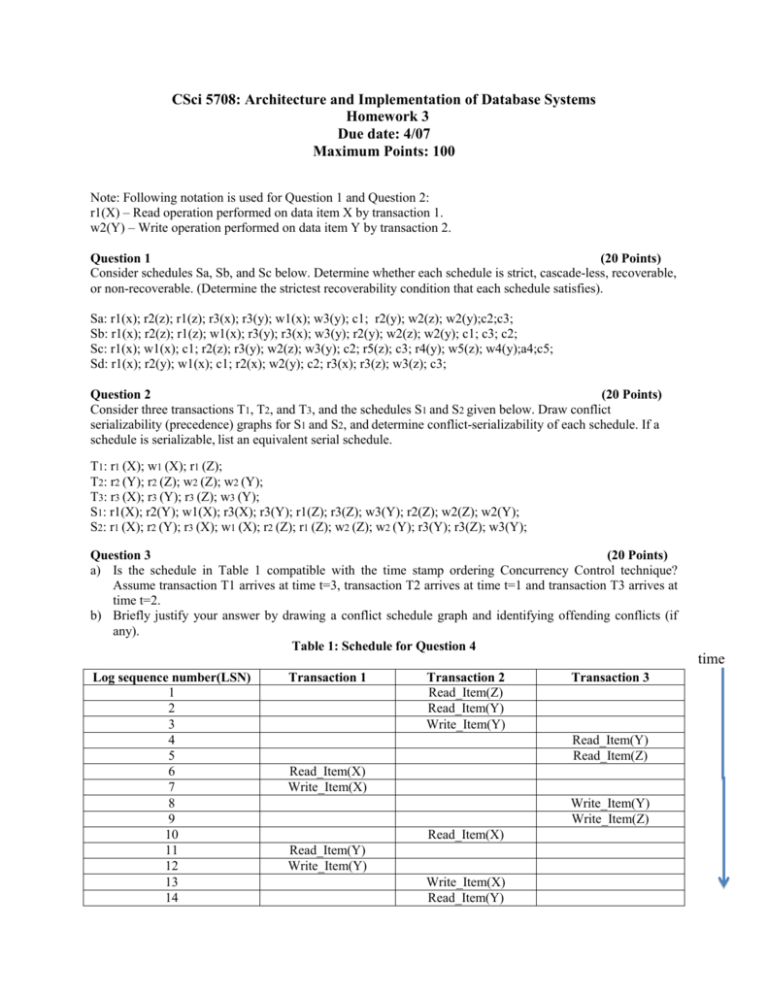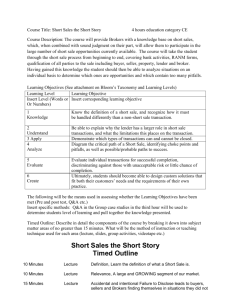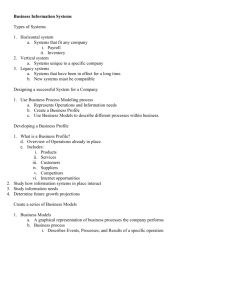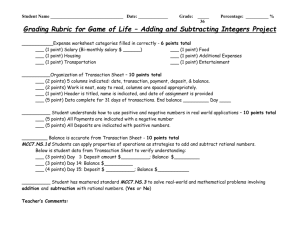Written Problems - Spatial Database Group
advertisement

CSci 5708: Architecture and Implementation of Database Systems Homework 3 Due date: 4/07 Maximum Points: 100 Note: Following notation is used for Question 1 and Question 2: r1(X) – Read operation performed on data item X by transaction 1. w2(Y) – Write operation performed on data item Y by transaction 2. Question 1 (20 Points) Consider schedules Sa, Sb, and Sc below. Determine whether each schedule is strict, cascade-less, recoverable, or non-recoverable. (Determine the strictest recoverability condition that each schedule satisfies). Sa: r1(x); r2(z); r1(z); r3(x); r3(y); w1(x); w3(y); c1; r2(y); w2(z); w2(y);c2;c3; Sb: r1(x); r2(z); r1(z); w1(x); r3(y); r3(x); w3(y); r2(y); w2(z); w2(y); c1; c3; c2; Sc: r1(x); w1(x); c1; r2(z); r3(y); w2(z); w3(y); c2; r5(z); c3; r4(y); w5(z); w4(y);a4;c5; Sd: r1(x); r2(y); w1(x); c1; r2(x); w2(y); c2; r3(x); r3(z); w3(z); c3; Question 2 (20 Points) Consider three transactions T1, T2, and T3, and the schedules S1 and S2 given below. Draw conflict serializability (precedence) graphs for S1 and S2, and determine conflict-serializability of each schedule. If a schedule is serializable, list an equivalent serial schedule. T1: r1 (X); w1 (X); r1 (Z); T2: r2 (Y); r2 (Z); w2 (Z); w2 (Y); T3: r3 (X); r3 (Y); r3 (Z); w3 (Y); S1: r1(X); r2(Y); w1(X); r3(X); r3(Y); r1(Z); r3(Z); w3(Y); r2(Z); w2(Z); w2(Y); S2: r1 (X); r2 (Y); r3 (X); w1 (X); r2 (Z); r1 (Z); w2 (Z); w2 (Y); r3(Y); r3(Z); w3(Y); Question 3 (20 Points) a) Is the schedule in Table 1 compatible with the time stamp ordering Concurrency Control technique? Assume transaction T1 arrives at time t=3, transaction T2 arrives at time t=1 and transaction T3 arrives at time t=2. b) Briefly justify your answer by drawing a conflict schedule graph and identifying offending conflicts (if any). Table 1: Schedule for Question 4 time Log sequence number(LSN) 1 2 3 4 5 6 7 8 9 10 11 12 13 14 Transaction 1 Transaction 2 Read_Item(Z) Read_Item(Y) Write_Item(Y) Transaction 3 Read_Item(Y) Read_Item(Z) Read_Item(X) Write_Item(X) Write_Item(Y) Write_Item(Z) Read_Item(X) Read_Item(Y) Write_Item(Y) Write_Item(X) Read_Item(Y) Question 4 (20 Points) Table 3 shows the log of operations from transactions T1, T2, T3 and T4 before a power failure. Suppose that the DBMS uses the immediate update based recovery algorithm. a) Is the schedule represented by the log in Table 3 recoverable (without rolling back any committed transactions) ? b) Describe the recovery process after a system restart. Specify which transactions are rolled back, which operations in the log are redone and which operations (if any) are undone, and whether any cascading rollback takes place. Show your answer in a tabular form shown below in Table 2: Table 2: Summary answer. Committed transactions Active transactions Redone operations Rolled back transactions Cascaded rollback transactions Undone operations Table 3: Log file retrieved for the Schedule for Question 5. Log sequence number(LSN) 1 2 3 4 5 6 7 8 9 10 11 12 13 14 15 16 17 18 19 Schedule/(log of operations) [Start_transaction, T1] [read_item, T1, A] [read_item, T1,D] [write_item, T1, D, 20,25] [Commit, T1] [checkpoint] [start_transaction, T2] [read_item, T2, B] [write_item, T2, B, 12, 18] [Commit, T2] [start_transaction, T4] [read_item, T4, D] [write_item, T4, D, 25, 15] [start_transaction, T3] [write_item, T3, C, 30, 40] [write_item, T3, F, 45, 60] [read_item T4, E] [write_item, T4, E, 30, 20] [commit, T4] System Crash Question 5 Repeat the above question using deferred update based recovery algorithm. (20 Points)











